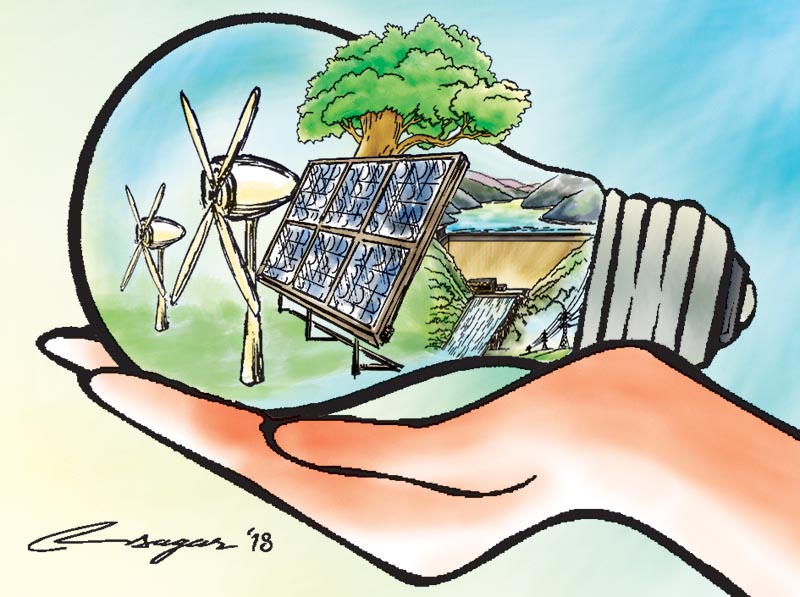Going for renewables: Time to identify sources
Some countries in the world have done very well in developing alternative energy sources, and Nepal can learn from them. A combination of political will, investments in renewable technologies and solid legal framework, however, is a must
The deliberations on sustainable development in recent years are based on the need to transition the sources of energy supply from non-renewable to renewable (or alternative energy). Non-renewable energy source is something which will eventually run out or that cannot be restored through natural processes. Fossil fuels, coal and petroleum are non-renewable energy. The biggest implications of these sources are carbon emissions, which are responsible for global warming.
Renewable energy sources on the other hand are something that can be restored by natural processes. For example, solar, wind, rain and geothermal energy. Ground water can be considered to be renewable source of energy if properly utilised.
The simple idea behind sustainable development is: national growth should be accelerated but while ensuring that future generations do not suffer environmentally or economically.
Currently, biomass is the most important source of energy in Nepal, accounting for 77 per cent of the total energy source (Biomass Strategy 2017). Biomass is the energy produced by the burning of wood, and other organic matters. The use of biomass causes carbon footprints, but it is still recognised as a renewable energy by the European Union and United Nations legal framework.
The current problem in Nepal, however, is over-dependency on biomass to meet energy demands. In the last decade alone it is believed that over-exploitation of wood is approximately 10 million tonnes (WECS). This causes severe deforestation, and the loss of natural habitat, and the increase in the carbon footprint, which the parties to the Paris Agreement 2015 have vouched to limit, control and monitor.
Petroleum is the second most used energy source amounting for 11 per cent of the primary energy consumption (International Energy Agency 2016).
Since Nepal meets all of its petroleum product demand through imports, it is a huge economic burden.
Majority of the electricity demand in Nepal is met by hydropower plants. However, we are yet to fully utilise our water sources for energy production.
In this context, it is important for Nepal to identify and explore other feasible energy sources. Nepal can look for inspiration from other countries that have successfully harnessed their capacity to develop alternative sources
of energy.
Sweden, for example, in 2010 produced more energy from biomass than petroleum products. Investment in technology-driven biomass plants has pushed the Northern European country’s energy consumption from biomass from 88 terawatt hours to 115 terawatt hours in the last half decade. This is almost 40 per cent of the total energy demand. The nation’s energy policy has been commended by the IEA. The legal framework sets the target of having no carbon emissions by 2045, a 100 per cent renewable electricity generation by 2040, and a constant development in the sector of renewable energy.
Costa Rica, a small Central American nation, produced 99 per cent of its energy from renewable source in 2015. Much of it came from hydropower, accompanied by geothermal energy, solar, biomass and wind power. The country has become the leading example for cutting on its fossil fuel dependency, by successfully powering its national grid by a hundred per cent of renewable energy for 285 days in 2015. With proper utilisation of technological, financial and political resources, the nation has been able to produce 75 per cent of its electricity from hydroelectricity plants.
Costa Rica’s domestic law (The Regulations on the Efficient use of Energy) encourages the development and use of renewable energy sources, allowing for an investment friendly environment, complemented by a strong determination by political leaders, and civil society.
Our northern neighbour China is also setting a good example when it comes to wind power. It has the largest installed capacity of 149 gigawatt and is on track to achieving the government’s pledge to produce 15 per cent of its energy from renewables by 2020. As the world’s fastest growing economy, electricity demand of China increases by almost 10 per cent a year. Most of the power demand is fulfilled by coal plants, which China realises could have a devastating impact on the environment.
And there is Iceland whose sustainable energy situation can be a model for the world. Today, it is the only country in the world that produces 100 per cent of its energy from renewables—87 per cent comes from hydropower and 13 per cent from geothermal power.
Countries like Germany, Denmark, Scotland and Morocco among others have also established a strong vision in developing the renewable energy sector. The common factor here is the combination of strong political will, investments in renewable energy technologies and an equally solid legal framework.
Nepal currently has been able to harness roughly 1,000 megawatts of electricity out of the total economically feasible 43,000 megawatts from hydropower plants.
On a positive note, 113 hydropower plants are under construction as of March 2018, which will have a total capacity of 3,000 megawatts.
Every nation has potential sources of alternative energy, but the true success is in employing them and taking benefits from them.






